Conscription 2 years Reserve personnel 20,000 - 30,000 Founded 9 May 1992 | Active personnel 18,500 - 25,000 Headquarters Stepanakert Military age 18 | |
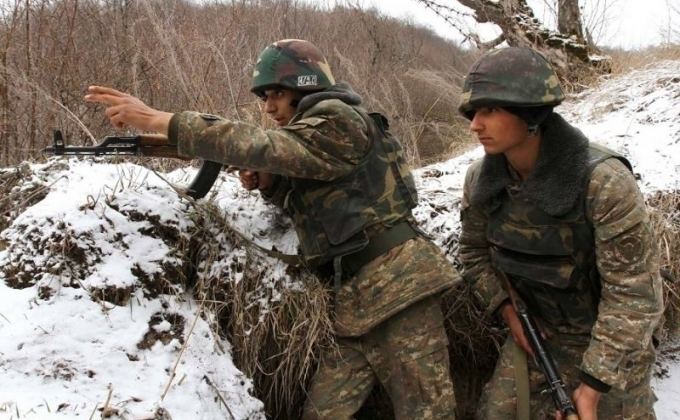 | ||
Service branches Army
Air Force
Air Defense Commander-in-Chief President Bako Sahakyan Minister of Defense Lieutenant General Movses Hakobyan Similar Azerbaijani Armed Forces, Armenian Army, Azerbaijani Land Forces, Azerbaijani Air and Air Defence, Armenian Air Force | ||
Azerbaijani drone purportedly shot down by nagorno karabakh defense army
The Nagorno-Karabakh Republic Defense Army (Armenian: Լեռնային Ղարաբաղի Հանրապետության պաշտպանության բանակ, Lerrnayin Gharabaghi Hanrapetut’yan pashtpanut’yan banak) is the formal defense force of the largely unrecognized Nagorno-Karabakh Republic (NKR). Established in 1992, it united previously disorganized self-defense units which were formed in the early 1990s with the avowed goal of protecting the ethnic Armenian population of Nagorno-Karabakh from the attacks by the Soviet and Azerbaijani armed forces. The Nagorno-Karabakh Defense Army is currently composed of around 20,000 well-trained and equipped officers and soldiers and maintains a "constant state of readiness, undergoing more serious combat training and operational exercises than any other former Soviet army."
Contents
- Azerbaijani drone purportedly shot down by nagorno karabakh defense army
- nagorno karabakh defense army special forces
- Establishment
- Nagorno Karabakh War
- Post war
- Equipment
- Air Force
- Main battles participated in
- References
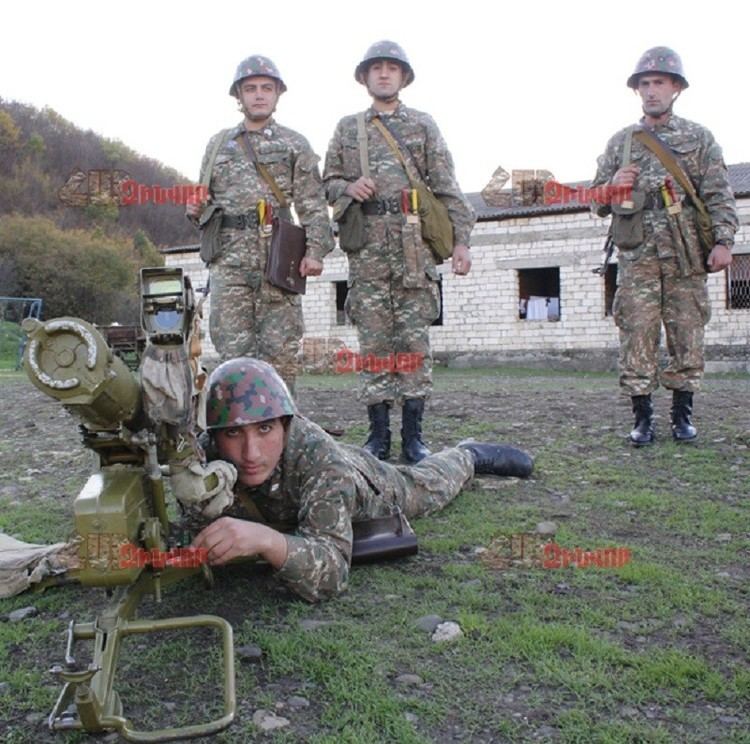
nagorno karabakh defense army special forces
Establishment
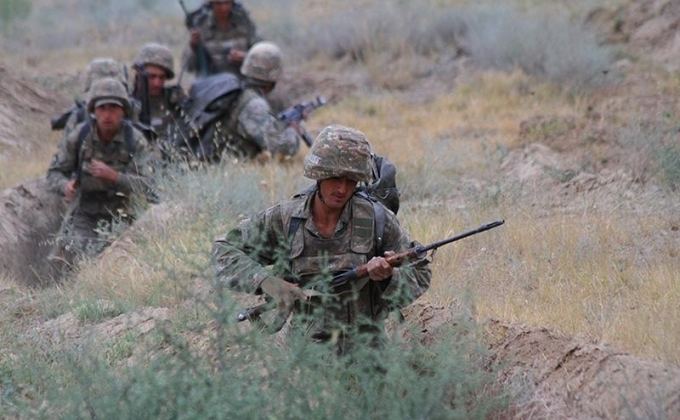
The Nagorno-Karabakh Defense Army was founded on May 9, 1992. It created "its own central command and military structure distinct from the Armenian Army." Its founders included Robert Kocharyan (the former president of Armenia, he was the first commander in chief of the Army); Serzh Sargsyan (current president of Armenia); Vazgen Sargsyan (Armenia's Defense Minister 1992-93, State Minister in Charge of defence 1993-95, Armenia's Prime-Minister 1998-99); Monte Melkonian (responsible for Martuni region); Samvel Babayan (Nagorno Karabakh's Defence Minister from 1994 to 2000) and others. Many of the men who served in its ranks and in the officer corps during the Nagorno-Karabakh War were seasoned veterans of the Soviet military and had fought with distinction in the Soviet war in Afghanistan.
Nagorno-Karabakh War
The formal formation of the NKR Defense Army was rooted in the concept of the Jokat (volunteer detachment). With the early outbreak of hostilities prior to 1992, Armenians of Nagorno-Karabakh began forming small detachments of volunteers, often self-described as Fedayeen, inheriting the name of the fighters who actively resisted the Ottoman Empire in the final decades of the nineteenth and early decades of the twentieth centuries.
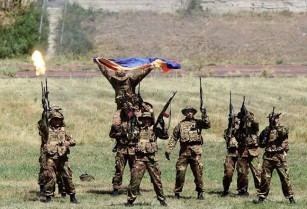
At the outset these detachments were small groups of no more than 12-40 men. For example, during Operation Ring, Shahumyan was defended by a force as small as 22 men under the command of Tatul Krpeyan. These volunteer militia would initially arm themselves with whatever was available, including hunting shotguns borrowed from local farmers and even home-made rifles. In the later stages of the war, these units armed themselves with AK-47s, RPGs and sometimes portable anti-aircraft MANPADs, transforming the defense force into a highly mobile and flexible force that was capable of waging guerilla warfare. Likewise, these units initially had no heavy military equipment, but later started taking over large quantities of Azerbaijani tanks and armored personnel carriers that were abandoned on the battlefield. Most of these captured tanks and APCs later became part of the NKR Defense Army's equipment. Improvisation, multi-functionality, creativity, strong-morale, focus on defensive tactics, adaptation, flexibility, high-mobility and a native knowledge of the mountainous terrain are all important factors in understanding the combat success of these small units.
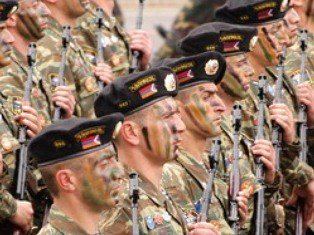
The initial purpose of these detachments, made up of volunteers, was mainly to defend Armenian civilian population, each in a particular village or town. Each of them was operating independently with no central command or leadership. Yet, these units would regularly collaborate in joint operations such as the battle of Khojaly in February 1992 or the June 1992 surprise counter-offensives during operation Goranboy. The increasing scale and intensity of Azeri attacks, the devastation caused by Grad multiple rocket launchers firing from Shushi and the Lachin, the blockade from mainland Armenia had broadened the notion of security beyond the mere defense of a small village. Capturing Shushi and Lachin as well as turning the tide of operation Goranboy became, for the Armenians, not only a matter of security, but that of survival. For the successful conduct of such large-scale operations, the detachments had to be consolidated under a single, unified command.
Mient Jan Faber argues that "August 1992 marked the watershed between purely voluntary Armenian Karabakh forces reinforced by volunteers from Armenia and an organised NKR army with its own central command and a military structure distinct from the Armenian army."
Post war
The Nagorno-Karabakh Defense Army's primary role after the conclusion of the Nagorno-Karabakh War in 1994 is the protection of the NKR from foreign and domestic threats. Though the war ended with the signing of a cease fire between Armenia, Nagorno-Karabakh and Azerbaijan and the de facto independence of the NKR, the Azerbaijani leadership has repeatedly threatened to restart hostilities to retake the region. Violations of the cease fire along the line of contact are frequent and often result in the deaths of several soldiers and civilians each year. One of the most significant breaches of the ceasefire occurred in Martakert on March 8, 2008, when up to sixteen soldiers were killed. Both sides accused the other of starting the battle. In June 2010, new skirmishes broke out between Armenian and Azerbaijani troops along the line of contact, resulting in the deaths of four Armenian servicemen. Clashes in summer 2014 resulted in the deaths of six Armenian and thirteen Azerbaijani servicemen. On November 12, 2014, a Nagorno-Karabakh Defense Army Mi-24 attack helicopter participating in the week-long joint Armenian-NKR Unity 2014 military exercises was shot down by the Azerbaijani military, killing all three crew members. On April 1, 2016 war-like clashes began; according to several sources it was the worst since 1994.
Equipment
The Nagorno-Karabakh Defense Army's equipment consists of infantry, tanks, artillery and anti-aircraft systems. The Karabakh army's heavy military hardware includes:
As for infantry weapon most rely on the AK-74 rifle and older AKMs in reserve for standard issue rifles. While other basic weapons consists of Makarov PM pistols PK machine guns and RPG-7 rocket launchers mostly supplied by Armenia. The Nagorno-Karabakh military is deeply integrated with the Armenian military, and the NKR depends on the Armenian Army to ensure its survival as an independent national entity. Armenia considers any act of aggression against Karabakh as an act of aggression against itself.
Air Force
The Nagorno-Karabakh Defense Army maintains a small air-force with a personnel of around 250 men.
